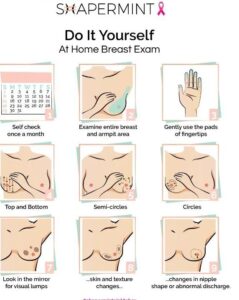Health
Symptoms & Treatment Of Bre@st Cancer

Breast cancer is one of the various types of cancers we have in the world. Breast cancer is the type of cancer that forms in the breast cells. The breast is made up of the ducts, connective tissue and lobules.
The lobules are glands that produce milk, the ducts are tubes that carry the milk produced by the lobules to the nipple while the connective tissue holds everything together. Breast cancer starts in the inner lining of the milk ducts or lobules which supplement milk.

In this article, you will get to know more about breast cancer, symptoms and treatment. Before we start listing the breast cancer symptoms and treatment, let’s bring to your notice the causes of breast cancer and factors that could influence the growth of cancer in your breast.
Factors That Could Influence Growth of Breast Cancer
Genes: Having a BRCA1 or BRCA2 gene is a factor that could influence the growth of cancerous cells in the breast and ovaries too.
Family History: If a family member has gotten breast cancer before, there is a possibility of another female in the family getting it too.
Being female: Being a female puts you at risk of developing a breast cancer and that is why you have to examine yourself monthly.
If you had had a breast cancer on one breast, you could develop another on the other breast even after the first one had been treated.
Radiation Exposure: Receiving radiation treatment on your chest might put you at risk of having breast cancer.
Obesity
Alcohol: People who always drink alcohol put themselves at risk of developing cancerous cells in their breast.
Women who have never gotten pregnant can be at risk. Getting pregnant for the first time at an old age.
Early Menstruation: A female who began her monthly flow before the age of 12 might be at risk of having breast cancer later on in life.
Breast cancer is not only for women as it also affects the males but it is mainly seen in females.
What Are The Symptoms of Breast Cancer?
Change in the shape or appearance of breast
Redness of the skin over the breast
Lump in the breast
Rash on the nipple
Discharge from the nipple and sometimes the discharge may contain blood
Scaling of the skin of the breast or nipple
Inverted or sunken nipple
There are different types of breast cancer and also different stages of breast cancer.
Types of Breast Cancer
1. Invasive Lobular Carcinoma
In invasive lobula carcinoma, the cancer cells start from the lobules and then spread to the breast tissues. It could also spread to other parts of the body.
2. Lobular Carcinoma In Situ(LCIS)
This cancer cell grows in the glands of the breast that produce milk. Here, the cancer hasn’t affected other surrounding tissues yet.
3. Invasive Ductal Carcinoma
In this type of breast cancer, the cancer cells start in the breast milk ducts and then grows to affect other parts of the breast tissue. It is the most common type of breast cancer.
4. Ductal Carcinoma In Situ(DCIS)
The cancer cells are only in the ducts of the breast.
5. Paget Disease
The paget disease of the nipple starts in the duct of the nipple and with time affects the skin and areola of the nipple.
6. Angiosarcoma
This cancer grows on the lymph vessel of the breast or on blood vessel.
7. Inflammatory Breast Cancer
Here, the lymph nodes close to the breast are blocked by cells. The breast starts swelling and also looks red.
8. Metastatic Breast Cancer
Metastatic breast cancer is the type of cancer where the cancer has spread to other parts of the body like the bones, lungs, etc.
What Are The Stages Of Breast Cancer?
1. Stage 0
In stage 0, the cancerous cells are seen within the breast ducts or milk glands and it remains there.
2. Stage 1
Here the cancerous cells have broken free to attack healthy tissue such as the fatty breast tissue. There might not be tumor and if there is, it is about 2cm. Also, no lymph node is affected yet.
3. Stage 2
The tumor is larger than 2 cm but not larger than 5 cm, small groups of breast cancer cells — larger than 0.2 mm but not larger than 2 mm, are found in the lymph nodes. It could also be that the tumor is larger than 2 cm but cannot be larger than 5 cm. Here, cancer has spread to one to three axillary lymph nodes or to lymph nodes near the breastbone. Sometimes the tumor is larger than 5 cm but it is yet to spread to the axillary lymph nodes.
4. Stage 3
Here, the cancer has spread to 10 or more axillary lymph nodes, but there might still be no sign of cancer in the breast for some people in this stage.
5. Stage 4
In stage 4 breast cancer, the cancer has spread to other organs like the liver, lungs, skin, brain or the bones.
How To Diagnose Breast Cancer?
1. Imaging Test
Imaging test may be in form of ultrasound, diagnostic mammogram, and breast magnetic resonance imaging.
Ultrasound: This scan helps the doctor differentiate between a fluid filled cyst and solid mass using sound waves.
Breast Magnetic Resonance Imaging(MRI): This type of scan uses a magnet which is connected to a computer. The MRI scan is done to show detailed pictures of inner areas of the breast.
Diagnostic mammogram: This type of xray produces images that can either show abnormalities or lumps.
2. Biopsy
In this type of diagnosis, a sample of tissue is extracted and sent to the lab for analysis.
3. Breast Examination
In breast examination, the breasts are examined monthly in order to check for a sign of lump. To do this, take off your cloth and bra and stand firm in front of a mirror, look out for any changes in your breast or nipple. Raise your arms high overhead and check for any changes in your breast or nipple,your hands on your hips and press it in order to make your chest muscles flex and look out for the same thing. Another way to do self examination is by putting a pillow under your right shoulder while lying down, place your right arm behind your head. You then use the pad of your left hand finger to press all parts of the breast tissue and under your arm. Do same for the other breast using another hand and gently press the nipple to check for a discharge. This should be done when your monthly flow is still on and for those in menopause, it should be done once a month at a fixed day.
How To Treat Breast Cancer
The treatment depends on the sensitivity of the hormones, the person’s age, health and type or stage of cancer.
Hormone blocking therapy: This is mainly used on people who are not fit for surgery.
Chemotherapy: This uses drug with powerful chemicals to kill fast-growing cells in your body. Sometimes it is done before surgery in order to shrink the tumor so it becomes easy for the doctor to remove.
Radiotherapy: High doses of radiation are used to kill cancer cells or shink tumors. It is done one month after surgery in order to kill left over cancer cells.
Surgery: Surgery can be mastectomy, lumpectomy, sentinel node biopsy or reconstruction. Mastectomy might be recommended for those still in the early stage of breast cancer. Here a surgery is done in order to remove all breast tissue from a breast as a way to treat or prevent breast cancer. In lumpectomy, a surgery is done to remove cancer or other abnormal tissue from the breast, sometimes other healthy tissues are also removed. If the cancer affects just one part of your breast or the tumor is small compared to the size of your breast, you may be advised to do a lumpectomy. Sentinel node biopsy is used to check if cancer has spread beyond a primary tumor into your lymphatic system.
How to Prevent Breast Cancer
The following are ways in which you can prevent breast cancer
Conduct a monthly self examination on your breast. Doing this will enable you spot out a change quickly. If you notice a lump visit a doctor
Always exercise
Maintain a normal body weight
Avoid alcohol and if you’re to take, it should be in moderate quantity
Eat healthy
Breast cancer is not a death sentence as some people believe, according to the American Cancer Solution, the chance of dying from breast cancer is around 1 in 38. What this means is that you can survive it. Early detection of lumps can help in the treatment of breast cancer though not all lumps are cancerous. Ensure you conduct a monthly self examination on your breast and if you can’t do it, you could book an appointment with your doctor. Breast cancer is not transmittable so you’re safe using the property of one who has been diagnosed with the cancer

